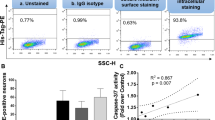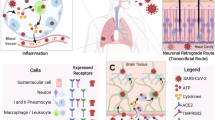Abstract
HIV infection can cause extensive neuronal loss and clinically a severe dementia. The cause of the neurotoxicity remains unclear as neurons are not infected, but disturbance of glutamate-linked calcium entry has been implicated. In this study, we have shown a decrease in HIV-infected brain of the expression of mRNA and protein of the GluR-A flop subtype of α-amino-3-hydroxy-5-methyl-4-isoxazole propionic acid (AMPA) glutamate receptor in cerebellar Purkinje cells. Although Purkinje cells are relatively resistant to loss, the observed disturbance of AMPA receptors may contribute to the neurotoxic process in other vulnerable brain regions and clinically to the development of dementia.
This is a preview of subscription content, access via your institution
Access options
Subscribe to this journal
Receive 12 print issues and online access
$209.00 per year
only $17.42 per issue
Buy this article
- Purchase on Springer Link
- Instant access to full article PDF
Prices may be subject to local taxes which are calculated during checkout
Similar content being viewed by others
References
Everall, I.P., Luthert, P.J. & Lantos, P.L. Neuronal loss in the frontal cortex in HIV infection. Lancet 337, 1119–1121 (1991).
Everall, I.P., Luthert, P.J. & Lantos, P.L. Neuronal number and volume alterations in the neocortex of HIV infected individuals. J. Neurol. Neurosurg. Psychiatry 56, 481–486 (1993).
Wiley, C.A. et al. Neocortical damage during HIV infection. Ann. Neural. 29, 651–657 (1991).
Everall, I.P. et al. Neuronal loss in symptom-free HIV infection. Lancet 340, 1413 (1992).
Everall, I.P., Glass, J.D., McArthur, J., Spargo, E. & Lantos, P. Neuronal density in the superior frontal and temporal gyri does not correlate with the degree of human immunodeficiency virus-associated dementia. Acta. Neuropathol. 88, 538–544 (1994).
Heyes, M.P. et al. Quinolinic acid in cerebrospinal fluid and serum in HIV-1 infection: Relationship to clinical and neurological status. Ann. Neurol. 29, 202–209 (1991).
Hill, J.M., Mervis, R.F., Avidor, R., Moody, T.W. & Brenneman, D.E. HIV envelope protein-induced neuronal damage and retardation of behavioural development in rat neonates. Brain Res. 603, 222–233 (1993).
Hollman, M., O'Shea-Greenfield, A., Rogers, S.W. & Heinemann, S. Cloning by functional expression of a member of the glutamate receptor family. Nature 342, 643–648 (1989).
Keinänen, K. et al. A family of AMPA selective glutamate receptors. Science 249, 556–560 (1990).
Sommer, B. et al. Flip and flop: A cell-specific functional switch in glutamate-operated channels of the CNS. Science 249, 1580–1585 (1990).
Seeburg, P.H. The molecular biology of mamalian glutamate receptor channels. Trends Neurosci. 16, 359–365 (1993).
Garthwaite, J., Glutamate, nitric oxide and cell-cell signalling in the nervous system. Trends Neurosci. 14, 60–67 (1991).
Baude, A., Molnar, E., Latawiec, D., McIlhinney, R.A. & Somogyi, P. Synaptic and non-synaptic localization of the GluR1 subunit of the AMPA-type excitatory amino acid receptor in the rat cerebellum. J. Neurosci. 14, 2830–2843 (1994).
Brenneman, D.E. et al. Neuronal cell killing by the envelope protein of HIV and its prevention by vasoactive peptide. Nature 335, 639–642 (1988).
Dreyer, E.B., Kaiser, P.K., Offermann, J.T. & Lipton, S.A. HIV-1 coat protein neurotoxicity prevented by calcium channel antagonists. Science 248, 364–367 (1990).
Lipton, S.A. Calcium channel antagonists and human immunodeficiency virus coat protein-mediated neuronal injury. Ann. Neural. 30, 111–114 (1991).
Garcia-Ladona, F.J., Palacios, J.M., Probst, A., Wiser, H.G. & Mengod, G. Excitatory amino acid AMPA receptor mRNA localization in several regions of normal and neurological disease affected human brain. An in situ hybridization histochemistry study. Molec. Brain Res. 21, 75–84 (1994).
Burnashev, N., Monyer, H., Seeburg, P.H. & Sakmann, B. Divalent ion permeability of AMPA receptor channels is dominated by the edited form of a single subunit. Neuron 8, 189–198 (1992).
Day, N.C. et al. Distribution of AMPA-selective glutamate receptor subunits in the human hippocampus and cerebellum. Molec. Brain Res. 31, 17–32 (1995).
Masliah, E., Ge, N., Achim, C.L., Hansen, L.A. & Wiley, C.A. Selective neuronal vulnerability in HIV encephalitis. J. Neuropath. exp. Neurol. 51, 585–593 (1992).
Benke, T.A., Jones, O.T., Collingridge, G.L. & Angeldes, K.L. N-Methyl-D-aspartate receptors are clustered and immobilized on dendrites of living cortical neurons. Proc. natn. Acad. Sci. U.S.A. 90, 7819–7823 (1993).
Linden, D. & Conner, J.A. Participation of postsynaptic PKC in cerebellar long-term depression in culture. Science 254, 1656–1659 (1991).
Garry, R.F., Kort, J.J., Koch-Nolte, F. & Koch, G. Similarities of viral proteins to toxins that interact with monovalent cation channels. AIDS 5, 1381–1384 (1991).
Magnuson, D.S., Knudson, B.E., Geiger, J.D., Brownstone, R.M. & Nath, A. Human immunodeficiency virus type 1 tat activates non-N-methyl-D-aspartate excitatory amino acid receptors and causes neurotoxicity. Ann. Neurol. 37, 373–380 (1995).
Werner, T. et al. HIV-1 nef protein exhibits structural and functional similarity to scorpion peptides interacting with K+ channels. AIDS 5, 1301–1308 (1991).
Saito, Y. Overexpression of nef as a marker for restricted HIV-1 infection of astrocytes in postmortem pediatric central nervous tissues. Neurology 44, 474–481 (1994).
Frankel, A.D. & Pabo, C.O. cellular uptake of the tat protein from human immunodeficiency virus. Cell 55, 1189–1193 (1988).
Diop, A.G. et al. Tetrodotxin blocks HIV coat protein (gp120) toxicity in primary neuronal cultures. Neurosci. Lett. 165, 187–190 (1994).
Hall, T.C., Miller, A.K.H. & Corsellis, J.A.N. Variations in the human purkinje cell population according to age and sex. Neuropath. Appl. Neurobiol. 1, 267–292 (1975).
Clark, P.J. & Evans, F.C. Distance to nearest neighbour as a measure of spatial relationships in populations. Ecology 35, 445–453 (1954).
Author information
Authors and Affiliations
Rights and permissions
About this article
Cite this article
Everall, I., Hudson, L., Al-Sarraj, S. et al. Decreased expression of AMPA receptor messenger RNA and protein in AIDS: A model for HIV-associated neurotoxicity. Nat Med 1, 1174–1178 (1995). https://doi.org/10.1038/nm1195-1174
Received:
Accepted:
Published:
Issue Date:
DOI: https://doi.org/10.1038/nm1195-1174



